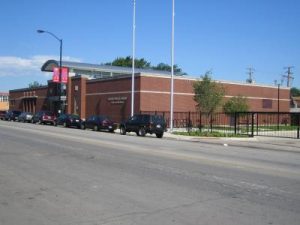4/21/2008
Maggie Killackey-Jurgensen, CPL, (312) 747-4051

While Earth Day will be marked in several settings around Chicago on April 22, the City of Chicago and its affiliates have been following the tenets of Earth Day on a regular basis, incorporating its message, literally, into the foundations of its buildings.
Vodak Branch Library, located at 3710 E. 106th St., is poised to become the seventh branch library to receive a plaque from the U.S. Green Building Council, honoring the building for its achieving of the council standards for LEED (Leadership in Energy and Environmental Design) certification. Built by the Public Building Commission of Chicago, the branch library is one of several buildings constructed by the PBC incorporating environmentally-sensitive features.
These facilities not only add to the fabric of the City of Chicago, but the manner in which they are built reflect the intentions of the City of Chicago, said Erin Lavin Cabonargi, Executive Director of the Public Building Commission. By incorporating elements of sustainable design into libraries, schools, police stations and fire houses, we stand as a leader in environmental awareness, and we encourage others – public and private alike – to adapt such practices themselves.
With the delivery of the plaque, Vodak Library will join Oriole Park, Logan Square, West Pullman, West Engelwood, West Chicago and Bucktown-Wicker Park as branch libraries who have earned plaques through LEED certification. The environmentally sensitive elements of the libraries are only one of many ways in which the Chicago Public Library serves as a green-friendly institution.
We are proud to have these elements in our new branch libraries, and we look forward to them being included in branches to be built in the future, said Mary Dempsey, Commissioner of the Chicago Public Library. With steps like these to reduce our ecological footprint, along with our incorporation of reading gardens and our collection of used batteries to keep dangerous chemicals away from our land, lakes and streams, the Chicago Public Library will stand on Earth Day proud of its policies and proud of its practices.
The Vodak Library plaque, to be installed soon at the Southeast Side facility, recognizes how the facilitys design, using light-reflective surfaces and landscaping, reduces the urban heat island effect, as well as how the air quality in the building is improved through the use of environmentally-sensitive chemicals in the construction process. Also, the majority of the building was constructed using materials manufactured within 500 miles, so less fuel was used in bringing those materials to the job site.
The City of Chicagos goal is for future newly constructed Chicago Public Library facilities to meet U.S. Green Buildings standards for LEED certification; as of today, no city agency has more LEED-accredited facilities than the Chicago Public Library. Also, the Library has 21 branches offering Reading Gardens that are open to the public year round. Reading Gardens offer patrons a place to enjoy lunch while reading a library book or serve as a location for book club discussions and childrens programming.
The City of Chicago has also initiated a city-wide battery collection program with all 79 Chicago Public Library locations serving as a drop off point. Batteries contain toxic heavy metals such as lead, mercury and cadmium which can threaten our environment if not properly discarded. Improperly disposed of batteries can pollute lakes and streams as the metals vaporize into the air when burned and expose the environment and water to lead and acid.
There are things residents can do today at the Chicago Public Library that will not only reduce their energy use, but also provide the added benefit of saving them money. Instead of buying personal books, CDs, DVDs and audio books Chicagoans can borrow them from Chicago Public Library for free. Additionally, the Chicago Publ
